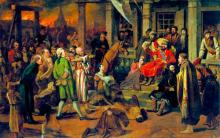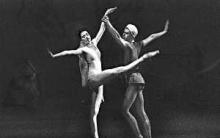Hello everyone! I will show you a method of electrochemical engraving, with which you can transfer a drawing printed on a laser printer to a knife, cleaver, or any other metal surface. I will transfer the drawing from the computer to the spatula for clarity of the process.
Search for a pattern
For work, we need an image that we will transfer. It is not difficult to find it on the World Wide Web. But there are certain requirements - it must be monochrome, black and white, without smooth transitions, only clear edges. If you have not found such a drawing on the Internet, then you can bring it to this form using a photo editor.Printing a drawing
We need special paper for printing. Ideally, a backing from the glue tape that is usually discarded will work. It has a coating, such as a wax, on which the adhesive film itself does not stick. At worst, you can use the pages of glossy magazines. Whoever has poisoned the boards himself at least once should understand without problems.In general, we cut out a format for an A4 or A5 printer from such a substrate and insert it into the printer. The printer must be laser, with powder paint.
We print the drawing at maximum quality, with the ink saving function disabled. After printing, cut off the excess edges of the paper.
Image to metal translation
You will need a regular iron for translation. It is good because it precisely maintains the set temperature, which is very important. Turn it over and set it to 130-150 degrees Celsius.While the iron is heating up, degrease the metal surface where the picture will be applied. This can be done with a cotton swab moistened with acetone, alcohol, or gasoline.

After that, put the spatula on the iron, wait a little while it heats up.

After a few minutes, we attach the image to the place. This must be done very carefully, without smearing the drawing.


Under the temperature, the ink melts and sticks to the metal.
Gently smooth out the picture through a cotton swab. You do not need to press hard - there is a danger that the paper will eat and smear everything. We iron everything for about 1-2 minutes. Be careful not to burn yourself.


Then we remove the spatula to the side and wait until it cools down. After cooling down, carefully peel off the paper. If you've used a glossy magazine, soak in water for a while and then peel off gently.
You should have a clear picture on the metal. If there are melts or thickenings, you can wipe off the ink with acetone and repeat the operation again.


Electrochemical etching of a pattern

In order not to etch too much, I will make a kind of barrier for the solution out of plasticine. I also pasted over the surface around the drawing with tape so as not to etch too much.

Let's prepare a saline solution.
Solution composition:
- - water 50 ml.
- - salt, ordinary kitchen - half a teaspoon.
Pour in saline solution.

And with a negative electrode (I use a regular self-tapping screw), we poison by immersing the electrode in the solution. The etching time is short: 20-30 seconds. In my observation, increasing the etching time does not have a very good effect on the pattern.

Then, we remove the plasticine barrier and see that everything has turned black.


Remove the printer ink with a cotton pad dipped in acetone. And we see that we have got an excellent engraving. Very clear, since I already have quite a lot of experience in this. Even the whiskers of the animal are visible!


I also made a drawing, but flipped the black and white in the editor.

The result of transferring the picture to metal
I am satisfied with the result, the quality is excellent. Now making a gift knife will not be difficult, for example.
Afterword
Etching can be carried out without electricity, using a different chemical solution.Etching can also be carried out without any plasticine barriers by simply wetting a cotton swab with a saline solution and attaching an electrode to it, directly acting on the metal. But I do not like this method, since the contact is made directly, which can erase small details of the ink.
Watch a video of the process -
If you can't do everything the first time, don't worry. Try again, it's not difficult.
It's nice to turn ordinary things "like everyone else's", with a little effort, into your own, cozy, personalized. A good way is to decorate them with an original pattern. And even if you consistently missed art lessons at school, and you draw a little worse than a fifth-grader, it doesn't matter. This simple method will allow you to decorate at least all textiles and wooden surfaces in the house with funny drawings. And please your friends with original gifts.

Authors of a popular resource among designers shutterstock offer to try simple home printing technology. It is available to every owner laser printer... Or someone who is not too lazy to go to the nearest copy center and print the desired drawing. This method will allow you to easily transfer the image to fabric or wood surface.

You will need:
Acetone (or a nail polish remover based on it);
Cotton pads;
Plastic card;
Scotch;
Ruler;
T-shirt / fabric / wooden surface to which the drawing will be transferred;
Desired image.
Step 1: print the picture on laser printer mirrored... An inkjet printer is a poor helper in this matter. does not guarantee an even distribution of ink, which will be reflected in the final result. The darker the original image, the better.

Step 2: lay down the sheet face down on a cloth or wood surface. It is advisable to fix it on one side with tape so that the picture "does not leave." Dampen a cotton ball or brush in acetone and wipe the back of the design thoroughly to keep the paper wet.

Step 3: take a plastic card and using it, like a scraper, go over the entire back of the drawing. It's like rubbing it. First from bottom to top, then from top to bottom, repeat several times. Do not press hard on the scraper to avoid tearing the print. The main rule is that all this time the paper with the image should be wet from acetone... This will help the design grab onto the fabric or wood.

Step 4: gently pull off the edge of the sheet with the image and evaluate how the process of "printing" goes. When the drawing is completely transferred, remove the paper.


All photos from the article
A distinctive feature of the age of high technology is the ease with which beauty is replicated and originality is put on stream. But if not everyone is given to become an artist and write great canvases, then many can create unique images using simple technologies.
Wood is one of the suitable materials on which a photo or favorite drawing will look great. In addition to the fact that the quality of the product will remain unchanged for many years, it will be a kind of masterpiece or piece goods, depending on how you dispose of it.

The essence of technology
Do not be afraid of such smart words as sublimation printing technology or gravure tone, because they are one and the same, therefore, already less incomprehensible. The technology is based on the principle of sublimation, when a substance under the influence of high temperature "jumps" from a gaseous state immediately into a solid, bypassing the wet stage.
Graverton technology allows you to transfer the pattern to wood, metal, glass, fabric, and the process itself takes place in a certain order:
- An image is printed on sublimation paper;
- The front side is applied to the object being processed;
- Placed in a heat press for a certain time.
A huge number of things can be subjected to artistic processing - from shoes, dishes, fabrics to corporate symbols, puzzles and all kinds of other unexpected things.
The main disadvantage of the graverton technology is the need for special equipment and its high price:
- sublimation printer(starting from 500 thousand rubles with kopecks);
- thermal transfer press(from 9 to 30 thousand rubles).
Very often we are faced with the question - how to translate a drawing on paper? The question is very important, because all further work depends on the quality of the translated image. You have found a wonderful drawing in a book or magazine, or maybe there is a beautiful embroidery in front of you that you want to repeat - the topic of transferring a drawing to paper is for you!
We are faced with a task - a clear, neat drawing must be copied from a sample drawing onto paper, which will then be transferred to another surface: fabric, leather, cardboard, paper, wood or plywood. In some cases, this drawing itself will be the basis for work, for example, as a coloring for children.
Let's consider with you several options for transferring a picture to paper.
OPTION 1.
Let's start with the most interesting and rather old method, which has been used by several generations of craftsmen in their work. He was especially respected by students, at the time of which the technique for printing drawings and texts was not yet so available. Many neat term papers and theses went through GLASS and were successfully defended.

In order for you to be able to transfer any drawing to paper using glass, you need a table lamp, two chairs and glass of any size. That's all - you have a reliable manual copying "technique" at your home under your guidance! Let's look at what to do now and how to transfer the drawing to paper using glazing.
We put on the glass (approximately above the lamp) the sample from which we will reshoot the drawing.

We put a blank sheet of paper on this sample.


A sufficiently bright light from a table lamp allows you to clearly see the pattern through all the layers of the paper. Take a pencil and trace all the lines of the lower drawing onto the upper blank sheet of paper.
In the event that you do not want the bottom sheet to be damaged from the pressure of the pencil, then circle the lines with light pressure. Then, after turning off the lamp, take a pencil and trace the lines more clearly.

The work is finished, the patterns have been transferred to a new sheet of paper. Thus, you can reshoot pictures not only from a simple sheet, but also from any book and magazine.

Glazing is a great way to transfer a pattern to paper!
Interestingly, the bright light of the lamp also breaks through the fabric, so you can reshoot the pattern from the embroidered products. This is done in the same way as when working with paper.

The napkin lies on the glass above the lamp. A blank sheet of paper is superimposed on top and the entire pattern is outlined with a pencil. Keep in mind that the embroidery is slightly convex and the top blank sheet of paper will not fit tightly on the napkin.

Figures translated by the method of glazing are neat. You can start work periodically, giving yourself time to rest, because the drawing lies in place without moving. This method is good for any drawings of any complexity.
OPTION 2.
If the drawing is small in size, then it can be transferred to paper on a regular WINDOW GLASS ... Besides, there are times when there is no opportunity and place to make a structure with glass, chairs and a lamp.

To prevent the bottom sample from moving, secure it to a blank sheet of paper with paper clips. A significant drawback when working - very fast hands get tired.
OPTION 3.
Usage COPY PAPER for the translation of the drawing is widely known. For work you need: a sample drawing, carbon copy, blank paper, pencil or pen.
All this is laid in this way - first a blank sheet, then a carbon copy with the coloring side down, a sample of the drawing is placed on top. Paper clips are needed so that nothing moves during work.
With a pencil, all the lines of the drawing are outlined with pressure, which remain on the bottom sheet of paper.

After finishing the work, we remove the carbon copy - the drawing is completely printed on a sheet of paper.

There are several disadvantages of transferring a drawing through a carbon copy - the sample, due to the frequent tracing with a pencil, is quickly worn out, the work is sloppy, this method is suitable for relatively small drawings.
OPTION 4.
In some cases, you can transfer the drawing directly to a thin tissue paper paper or thicker tracing paper.

This translucent paper is superimposed on a reference drawing, the outlines of which are outlined with a pencil or pen.

That's all. A lot has been written, but you need to know each of these options for translating a picture on paper. The work of needlewomen is quite diverse - you don't know when what knowledge will come in handy.
Let's summarize our “ manual "ways to translate a picture. So this:
- glazing over a table lamp,
- glazing on the window,
- using carbon paper,
- using tracing paper or tissue paper.
But! .. Modernity makes its own adjustments to the work of craftsmen. Desired drawing if desired, you can already find it on the Internet. And the pattern you like can bescan and electronically print on a printer.As a result, you will have a drawing on paper ready to work.Due to the fact that there is no manual drawing, time is significantly saved and after printing you can start directly to work.
If you have a photocopier nearby, then the sample drawing can be filmed on it, if necessary, enlarging or reducing it in size. The person serving this device knows its additional functions. Just tell me what percentage you would like to change the image.
So, the modern way of translating a picture is as follows:
- scan images from books and magazines and print,
- find a finished picture in electronic form and print,
- use a copier to copy, print and resizing the picture.
Copying, printing a picture of any size and color is done using modern technology in a matter of minutes. The print quality is excellent.
But think about it, if so far many masters use a simple pencil to transfer drawings to paper themselves, then this manual method is not so bad ... Time-tested!
Thank you and see you soon on the pages!
If you don’t know how to draw, but would like to learn, you should start with a simple one - copying drawings. For a start, this can be done using tracing paper. This method is the easiest to implement. Now let's take a closer look at how to transfer a drawing from
Instructions
To transfer a picture, follow the steps outlined below:
- Select the image and, putting tracing paper on it, draw around all the lines with firm pressure, using a black acrylic pen.
- Now we turn over the tracing paper and put it face down on the sheet of paper to which you want to transfer the image.
- We press firmly and pass over it with a hot iron.
- Now we remove the tracing paper and additionally draw lines that are not clear enough.
- The image is ready.
This method is used for simple pictures that do not contain a lot of complex details. Now you know how to transfer a design from paper to paper in a simple way. Having tried it, you can proceed to others.
More complicated way

You can use the copy grid to transfer complex patterns. With its help, it is also possible to reduce or increase the scale of the image itself.
- original drawing;
- transparencies;
- paper;
- duct tape;
- ruler;
- pencil.
Instructions
To master this method, follow these steps:
- Apply a transparent film to the original image, on which squares of the same size are shown.
- We apply the same cell on a blank sheet of paper if the picture is reproduced in the original. How do I transfer a drawing from paper to paper when the image needs to be resized? When increasing the size of the squares are made larger, when decreasing, respectively, smaller.
- Now all you have to do is transfer the image by cells.
- When the picture is completely transferred with the help of a pencil, you can start painting.
Now you know how to transfer an image from paper to paper. Let's consider other surfaces.
The body as the basis

A tattoo is a highlight of the appearance, but not everyone decides to apply a drawing on the skin, realizing that this decision is made for life. For people who are afraid of such an act, but want to decorate their body with a beautiful image, an excellent solution is. To learn how to transfer a drawing from paper to skin, you need to study the following information. The main stage is a clear drawing of the contours of the future image.
The picture can be applied to the body using:
- tracing paper.
The first way
For it, you need to do the following:
- Selecting a pattern, determining the place of its application, disinfecting the skin.
- Transfer of the image to a carbon copy. To do this, put the paper on top of the original and carefully outline all of its contours.
- We moisten the carbon copy with alcohol and apply it to the body.
- To make the outlines well-printed, circle them again through the carbon paper, being careful to leave it intact.
Second way
It is based on the use of tracing paper. You need to do the following steps:
- We draw the drawing itself with a helium pen.
- We disinfect the skin and smear it with soap.
- We apply tracing paper and outline the contours with a sharp object.
- Now we paint over the drawing.
If you do decide to apply a permanent pattern to your body, approach it very carefully. The main thing is to choose a good salon, take an allergic reaction test and make sure that all tools are disinfected.
How to transfer a drawing from paper to glass
For work, we take an image with good contours and a roll. For transfer, you need to purchase a felt-tip pen - a marker for glass, it fits well and is easily washed off from the surface.

Instructions:
- We take the film. Its size should be slightly larger than the drawing itself. The film is attached to the surface, which prevents the picture from getting lost.
- The image is put on film and outlined thinly and very neatly.
- Now the film is carefully transferred with the front side onto the previously prepared surface. Preparation consists in degreasing its front side. Make sure that the film is completely adhered to the glass, get rid of wrinkles and bubbles.
- For a clearer transfer, once again along the contour, outline the image with any sharp object.
- Now is the time to get rid of the polyethylene. We do this very carefully so as not to smear the drawing. If there are any inaccuracies somewhere, now is the time to fix them.
- Now we draw the outline. This can be done with acrylic paints and a paintbrush.
- After everything has dried, carefully remove the traces of the marker with cotton swabs dipped in liquid.
- Inside, the image is filled in any way. If the technique is stained glass, then everything is poured along the contour.
- After drying, for a longer service life of the product, the image can be baked or varnished. It all depends on where this item will be used.
How to transfer a drawing from paper to wood
In order to see your favorite image on a wooden base, you just need to follow the steps outlined below.

For work you will need:
- drawing printed on a laser printer;
- wooden plank;
- acrylic gel medium;
- flat tool for leveling the picture;
- paint and rag;
- soft paraffin or matte glue;
- 2 brushes.
Instructions:
- Image selection. This should be a drawing that will look nice on a wooden base. To give some resemblance to the vintage style, it can be processed in special programs.
- The image is printed only on a laser printer, this is the main condition.
- A smooth wooden base is selected.
- Now apply an even layer of gel medium. It is he who will help the image to be transferred to the prepared surface.
- We place the drawing with the front side to the base. At the moment of connection, bubbles appear, which, if possible, should be smoothed out.
- The work is finished for today, leave everything for the night, continue tomorrow.
- Now is the time to remove the paper. To do this, you need to wet it and wipe it with your fingers. Right now you are witnessing a miracle - when you remove the paper, you can see how the image remains on the tree.
- Now you can use wood paint. Keep track of its amount so that the image does not darken.
- Now apply liquid paraffin. If necessary, the last two steps can be repeated after the first layer has dried.
Other basics for image transfer
Metal is a base, also suitable for such "tricks". For neat and fairly accurate work, two center lines are drawn on it or the corners of the image are marked. Now let's take a closer look at how to transfer a drawing from paper to metal.
The most common is to use carbon paper for this. Since metal is a very tough material, it is coated with white or light paint. The transfer process begins after the varnish has completely dried, which is applied just before the start of the main work.
Instructions

This method requires compliance with the following rules:
- The pattern is very tightly attached to the product. To do this, you can use a soapy solution.
- Many craftsmen use a chasing gun for this work. With it, the image is very accurate - almost a jewelry work, which, however, takes a very long time and requires some preliminary training.
- The tool is taken with three fingers, resting on the ring, which serves as a kind of spring. The coin is located 2-3 mm from the drawing, its light strokes form a dotted line - the main outline of the image is drawn. The smaller the detail of the picture, the tighter it breaks through.
- When all the lines have been transferred, you can wash off the paint.
- The image can be varnished.
Now you know how to transfer a drawing from paper to paper, to leather, to glass, to wood and to metal. Go ahead for the tools, and good luck in your endeavors!











Pizza Thin Dough Recipe: Cooking
Snack profiteroles with savory filling - herring paste!
Cottage cheese pie with apples: a recipe for making at home Loose cottage cheese pie with apples
Cooking manti according to the best classic recipes Recipe dense dough for manti
Mushroom soup with barley recipe How to make pearl barley soup with mushrooms